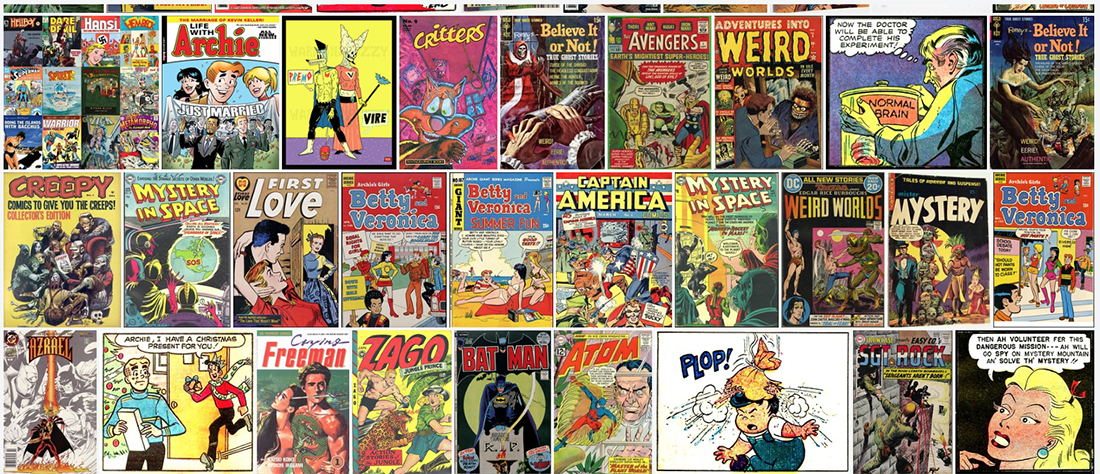[vc_row][vc_column][vc_single_image image=”108364″ img_size=”full”][vc_column_text]Nothing defined 20th-century American culture quite like the comic book. Comics in their popular, serialised form emerged in 1930s New York City, mass-produced by recent immigrants and their children who had grown up reading one-strip funny cartoons. The early success of Superman (the concoction of two young Jewish immigrants, Jerry Siegel and Joe Shuster) spurred the rapid growth of the comics industry. By the mid-1940s, many small-time comic publishers were churning out hundreds of series and characters of all genres.
Soon after comics’ meteoric rise in popularity, the industry drew criticism. Comics were never regarded as “high art” despite the aspirations of many who worked in the industry. They were unapologetically for children and adolescents, produced as entertainment for the lower classes. Many of the comics genres that rose to extreme popularity in the 1930s, 40s and 50s revolved around crime, ghosts and ghouls, aliens, and pulpy romance. Notably, EC Comics started by Bill Gaines was famous for Crime Does Not Pay, a comic that published macabre tales that blurred the line between good and evil. Gaines inherited the publishing business from his father, who had died suddenly in a boating accident, and EC comics became synonymous with the seediest corners of the comics industry.
Because of the gore and sexual content of early comics, the parents of devoted teenage comics readers began to worry about the effect of the comic book on children. The Catholic Church at the time allowed local dioceses to impose bans on certain books, which they quickly levied against most comic books, placing them on lists of books thought to be unsuitable for good Catholic youth. Concerned parents around the country wrote op-eds in local newspapers about the dangers of comics. Parent-teacher associations organised comic book burnings, though Nazi book burnings were still fresh in national memory. Students themselves occasionally spearheaded book burnings and comic purges from school libraries, encouraging friends to bring their collections to fuel the bonfire.
The final straw in the early 1950s was in the form of a book called Seduction of the Innocent, by psychologist Frederic Wertham. Wertham’s book contained no scientific research and was based solely on anecdotal interactions between the psychologist and patients at his clinic. It was unapologetically political and linked the rise of the comic book industry to rises in youth crime (which did not, statistically, exist). The central argument of his book was that the cartoon violence on the pages of comics spurred youth to commit more crimes and that banning comics would drastically decrease rates of youth criminality. Seduction of the Innocent spurred a series of Senate hearings on whether the government should take action against comics. Led by famous Senator Estes Kefauver, the hearings were televised for the comics-hating public to see. This was not the first time government action against comics had been considered: at that point, several bills had been introduced in different state legislatures to enact government censorship on the distribution of comics, though most had been shot down on First Amendment grounds.
The Senate hearings terrified the entire comics industry. Bill Gaines, high on stimulants, testified at the hearings. In a riveting cross-examination by Senator Kefauver, Gaines was backed into a corner, forced to defend a recent Crime Does Not Pay cover (which depicted a hand holding a severed woman’s head) as “good taste.” The Senate hearings led only to a harsh denouncement of comic books and endorsement of Wertham’s pseudoscientific theories about their link to youth crime. The government took no official action to censor comics, though it did encourage the industry to censor itself, which the industry gladly did.
Gaines had, years earlier, formed the Association of Comics Magazine Publishers (ACMP). In an effort to resist government censorship, Gaines rallied ACMP again, though fellow publishers thought it safer to develop intra-industry codes rather than to allow the government to officially censor comics. Fearful that government censorship was worse, the latent ACMP morphed into the Comics Magazine Association of America (CMAA). The CMAA then created the Comics Code Authority (CCA), which developed extremely strict guidelines for comics publishing–no weapons, good must always triumph over evil, women must be conservatively dressed. Since the CMAA controlled the means of production of comic books, without CCA approval no comics could go to the presses.
Full-time CCA censors would comb through every comic issue, circling any potential violations. The publishers who had previously specialised in crime comics, romances, science fiction and fantasy couldn’t get anything published — essentially, only superheroes remained. Comics became sanitised, and many smaller publishers closed down, with comics creators leaving the industry in droves. Bill Gaines’s EC Comics was finally shuttered when CCA censors objected to Gaines sympathetically portraying a black man in a comic.
The CCA’s regulations slowly loosened over time, yet the CCA remained essential in the industry for decades. Without the now-notorious CCA seal of approval on the cover, no comic would be sold. As independently publishing became easier and comics publishers consolidated, there became an independent financial motive for publishing and selling comics from many publishers regardless of their adherence to CCA standards. CCA standards also became looser, as artists infused already-popular series with themes that would have been previously unacceptable–for example, comic giant Jack Kirby famously included a storyline about drug addiction in a popular superhero series. In the 2000s, large publishers stopped seeking CCA approval, starting with Marvel Comics in 2001. By 2011, DC and Archie comics stopped seeking CCA approval for their comics, rendering the agency finally defunct.[/vc_column_text][/vc_column][/vc_row][vc_row][vc_column][vc_custom_heading text=”Banned Books Week / 22-28 Sept 2019″ use_theme_fonts=”yes” link=”url:https%3A%2F%2Fwww.bannedbooksweek.org.uk%2F|||”][vc_row_inner][vc_column_inner width=”1/4″][vc_single_image image=”103109″ img_size=”full” onclick=”custom_link” link=”https://www.bannedbooksweek.org.uk/”][/vc_column_inner][vc_column_inner width=”3/4″][vc_column_text]
Banned Books Week UK is a nationwide campaign for radical readers and rebellious readers of all ages celebrate the freedom to read. Between 22 – 28 September 2019, bookshops, libraries, schools, literary festivals and publishers will be hosting events and making noise about some of the most sordid, subversive, sensational and taboo-busting books around.
[/vc_column_text][/vc_column_inner][/vc_row_inner][/vc_column][/vc_row]





